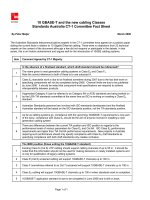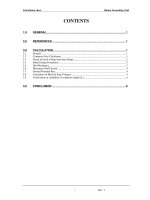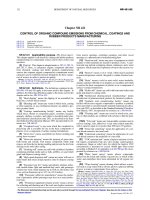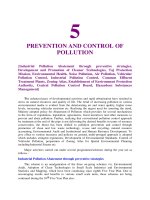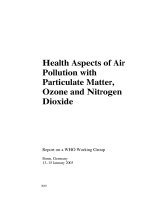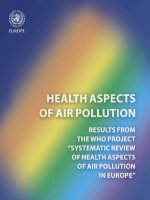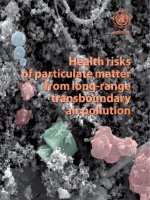Tài liệu FACT SHEET: Outdoor Air Pollution From Secondhand Smoke pptx
Bạn đang xem bản rút gọn của tài liệu. Xem và tải ngay bản đầy đủ của tài liệu tại đây (1.06 MB, 4 trang )
FACT SHEET: Outdoor Air Pollution From Secondhand Smoke
James L. Repace
Visiting Assistant Professor, Tufts University School of Medicine
and Repace Associates, Inc.
101 Felicia Lane, Bowie, MD 20720 U.S.A.
<www.repace.com>
1. Tobacco smoke contains at least 172 toxic substances, including 3 regulated
outdoor air pollutants, 33 Hazardous Air Pollutants, 47 Chemicals restricted as
Hazardous Waste and 67 Known Human or Animal Carcinogens (Repace, 2006).
This is true whether tobacco smoke is inhaled in the act of smoking, or inhaled by
nonsmokers out of the air indoors or outdoors.
2. The concentration of tobacco smoke pollution of buildings [secondhand smoke
(SHS)] is governed by the density of smokers and by the ventilation rate.
Tobacco smoke pollution outdoors or outdoor tobacco smoke (OTS) is
determined by the density of smokers, the wind velocity (direction and speed),
and the stablity of the atmosphere.
3. SHS concentrations persist for hours after smoking ceases indoors, while OTS
concentrations dissipate rapidly after smoking stops outdoors. However, during
smoking, OTS levels outdoors may be as high as SHS indoors.
4. A limited number of controlled experiments and field studies of OTS have been
conducted in California, Europe, in the Caribbean, and in Maryland:
• California (1). The California Air Resources Board study (CARB, 2006),
measured OTS nicotine concentrations outside an airport, college, government
center, office complex, and amusement park. CARB found that at these typical
outdoor locations, Californians may be exposed to OTS levels as high as indoor
SHS concentrations. CARB found that OTS was strongly affected by counts of
the number of smokers and moderately affected by the size of the smoking area
and the measured wind speed. The CARB study indicated that OTS
concentrations are detectable and sometimes comparable to indoor concentrations,
and demonstrates that the number of cigarettes being smoked (i.e., total source
strength), the position of smokers relative to the receptor, and atmospheric
conditions can lead to substantial variation in average exposures. CARB declared
that OTS is a “toxic air contaminant.”
• California (2). Klepeis, et al. (2007) measured OTS respirable particle
concentrations in outdoor patios, on airport and city sidewalks, and in parks.
They also conducted controlled experiments of SHS indoors and OTS outdoors.
Klepeis et al. (2007) found that mean SHS particle concentrations outdoors can be
comparable to SHS indoors. Within about 2 feet of a smoker OTS was quite high
and comparable to SHS concentrations measured indoors. They found that levels
measured in 2 sidewalk cafés were detectable at distances beyond 13 feet. They
found that in contrast to SHS, OTS does not accumulate and that OTS peaks are
more sensitive to source-receptor proximity and wind velocity. Thus, long-term
averages for OTS concentrations are averaged over a large number of transient
peaks, which only occur when smokers are active, whereas indoor concentrations
remain high long after cigarettes have ended, and the total dose to a person
indoors from each cigarette will be greater than for a cigarette smoked outdoors.
Klepeis et al. (2007) found upwind OTS concentrations very low and downwind
OTS much higher.
• Denmark. Boffi et al. (2006) measured OTS respirable particle pollution in a car
park (open space), outdoors in front of a conference center with smokers under a
roof (18 smokers during a measurement time of 35 min), indoors in the
nonsmoking conference center, along the motorway to Copenhagen city centre,
and inside a Copenhagen restaurant where smoking was allowed. Boffi et al.
(2006) found that mean values observed with smokers in front of the conference
center were significantly higher than the outdoor parking place, indoor conference
center, motorway and Copenhagen outdoor official data.
• Finland. Repace and Rupprecht (13 WCTOH, 2006 ) measured OTS respirable
particle pollution in Five outdoor cafes and on city streets in downtown Helsinki.
They found that air pollution levels in Helsinki outdoor cafes with many smokers
during August 2003 were 5 to 20 times higher than on the sidewalks of busy
streets polluted by bus, truck, and auto traffic.
• Maryland. Repace (2005) measured outdoor fine particle and carcinogen
concentrations from OTS on the campus of the University of Maryland at
Baltimore. Using controlled experiments, Repace (2005) found that cigarette
smoke RSP concentrations decline approximately inversely with distance
downwind from the point source, whereas cigarette smoke carcinogen
concentrations decline approximately inversely as the square of the distance from
source to receptor. The experiments showed that OTS smoke levels did not
approach background levels either for fine particles or carcinogens until about 23
feet from the source.
• Caribbean: Experiments conducted on a cruise ship underweigh at 20 knots at sea
in the Caribbean showed that OTS in various smoking-permitted outdoor areas of
the ship tripled the level of carcinogens to which nonsmokers were exposed
relative to indoor and outdoor areas in which smoking did not occur, despite the
strong breezes and unlimited dispersion volume. Moreover, outdoor smoking
areas were contaminated with carcinogens to nearly the same extent as a popular
casino on board in which smoking was permitted (Repace, 2005).
5. Conclusions: Field studies plus controlled experiments demonstrate that,
regardless of which way the wind blows, an individual in an outdoor cafe,
transiting through a building doorway, or otherwise surrounded by a group of
smokers, is always downwind from the source. They also show that under some
conditions, outdoor levels of tobacco smoke (OTS) can be as high as indoor levels
of secondhand smoke (SHS). Outdoor smoking bans are already common in
Canada (Figure below).
References:
CalEPA, 2006. California Environmental Protection Agency, Air Resources Board Office of Environmental Health
Hazard Assessment, State of California Proposed Identification of, Environmental Tobacco Smoke as a Toxic Air
Contaminant As Approved by the Scientific Review Panel, on June 24, 2005.
Klepeis, et al. (2007) Real-Time Measurement of Outdoor Tobacco Smoke
ParticlesJ. Air & Waste Manage. Assoc. 57:522–534
Repace (2005) Indoor and Outdoor Carcinogen Pollution on a Cruise Ship in the
Presence and Absence of Tobacco Smoking Presented at the 14th Annual Conference of the International Society of
Exposure Analysis, Oct. 17-21, Philadelphia, PA.
Repace JL and Rupprecht AA. Outdoor Air Pollution From Secondhand Smoke. Presented at the 13
th
World Conference
on Tobacco Or Health, Washington, DC, July 12-15, 2006.
Repace JL. Exposure to Secondhand Smoke. Chapter 9, In: Exposure Analysis, W Ott, A Steinemann, and L Wallace,
Eds. CRC Press (2006).
California: Officials in California Town Say Smoking Ban Is Working
Source: The Wall Street Journal Interactive Edition, 2006-05-30 Author: SHEARON ROBERTS; ORDINANCE NO.
2006-217 AN ORDINANCE OF THE CITY OF CALABASAS REGULATING SECOND-HAND SMOKE AND
AMENDING THE CALABASAS MUNICIPAL CODE
